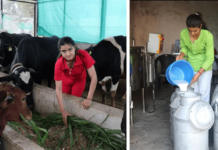Managers of around 3,000 privately-run markets are to meet and protest new rules that ban sale of animals for slaughter at cattle markets
New Delhi, June 13, 2017: Fridays are festive days at Pachokhara.
For nearly half-a-century now, farmers, cattle-rearers and tradesmen have made the weekly trip to the cricket stadium-sized grounds of the Upadhyay family— prominent local land-owners — to trade cattle.
A dirt road splits the ground into a section for buffaloes and another for cows, bulls, oxen and goats. There’s cash changing hands, frisky calves, hillocks of dung and no spot safe from a restive bovine’s quick but lethal flick of the hind leg.
And yet, it’s a lean day in Pachokhara in Firozabad district of Uttar Pradesh, a good 230 km from the national capital.
Slowdown in business
“Usually, Fridays are so crowded that newcomers will not be able to make their way to the exit…but now business is down,” says Anup Upadhyay (34), one of the younger members of the family, who oversees the functioning of the market.
There are multiple causes for the slow day. July to November are considered peak months for the cattle trade because farmers have spent money for sowing and other crop operations and are usually in need of cash till the harvest. Then there’s the weather, with the hot months generally considered insalubrious for the ferrying animals.
This year there’s another obstacle in the form of the amendment to the Prevention of Cruelty to Animals Act (1961) that governs the treatment of animals. On May 23, the Environment Ministry decreed that buffaloes and cattle could not be sold for slaughter at animal markets. Moreover, bovines once sold at such markets, cannot be traded for at least six months and all sales and records will come under the purview of a dedicated District Monitoring Committee.
To Mr. Upadhyay, these rules are the final blow to the cattle-trading business, which has been reeling under the assaults of cow vigilante groups. The danger of being waylaid and harassed — by both the police and vigilantes — for appropriate papers has already prevented several farmers from bringing their animals to the market.
“There is a fear and lots of rumours… Buffaloes cannot be sold…Bulls can’t be sold. These fuel uncertainty and keep farmers and sellers away,” he said, listing the pressures on the business.
Private markets
According to Thehindu.com the Upadhyays run one of 3,000 cattle markets across Uttar Pradesh. Unlike in Haryana and Punjab, these ‘Pashu Haats’ are privately managed. Land-owners provide a venue for buyers and sellers to come together and charge a commission on every animal sold. There’s also a space for registering the transactions and several rooms in the Upadhyay home, where disputes over prices and conditions of sale are negotiated and resolved.
Over a 1,000 head of cattle are paraded every Friday and about 300 of them sold during market hours that begin as early as nine in the morning and go till four in the afternoon.
Though the Pachokhara fair is reportedly the second largest in the State, the transactions overwhelmingly deal with the sale and purchase of milch and draught-animals. “No more than 1%-2% of the animals here are likely make their way to the slaughter houses,” said 65-year-old Brijesh Upadhyay, Anup’s uncle, who heads the cattle-market operations.
So far the market has not been significantly impacted by the notification because cattle markets have three months (from May 23) to implement the new rules. And the managers are hoping that in the interim, certain aspects of the proposed notification would be withdrawn.
“The cow is our sacred animal…we are Brahmins after all,” said Mr.Brijesh Upadhyay adding, “but the government should remove restrictions on all other animals…buffalo, bulls, oxen.”
For the first time, managers of the 3,000-odd animal markets are planning to meet this week and formally protest the May 23 notification. The senior Mr Upadhyay also does not put a number to the potential economic losses but says that if restrictions were imposed, farmers would be forced to start selling their animals at half the market rates because they wouldn’t have access to the several, potential buyers that would be present at a cattle market.
“You would have a few buyers approaching farmers at their farms and they would resort to distress sales,” he said. “There would be protests and agitation, like in Maharashtra and Madhya Pradesh [referring to ongoing farmers’ agitations].”
Cattle are farmers’ assets that they turn to during an emergency. Khairpal, who has come to sell his buffalo at the market, said he would no longer be able to support his older animals and would have to turn them loose on the roads. “In the evenings, you can see herds of male animals clogging the roads…they graze on standing crop and are a liability,” he told The Hindu.
Suraj, who helps transport animals from the fair, said “half” the buffaloes brought here were eventually for slaughter.
Ashok Kumar, who manages a cattle fair in Dalshahpur, close to Agra, said the government had not provided a solution for managing unproductive animals. “Gaushalas mostly exist on name only…such moves are hitting at an established revenue stream of farmers,” he told The Hindu over the phone.

































